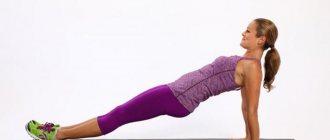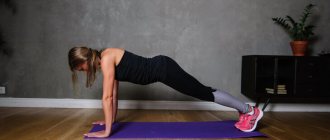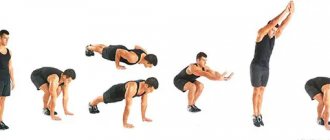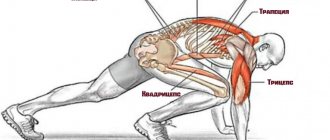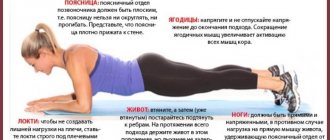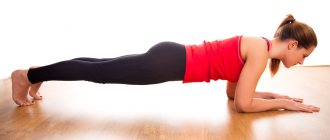Unlike the classic version, the side plank actively engages the oblique abdominal muscles and helps strengthen the hips and back. Correctly installed equipment at the initial stages is the key to success and progress.
The plank was created rather to diversify the training program and work the core muscles as effectively as possible. I like to do this exercise at the end of my workout so I can immediately spend strength and energy on the main exercises, and then finish it off with abdominal exercises.
The benefits and harms of exercise
The plank in the side position has virtually no disadvantages, there are only contraindications.
The main advantages of the side plank:
- Involvement of a large number of muscles without dynamic impact.
- Working out not only the external, but also the deep layers of muscles.
- Load on the rectus and oblique abdominal muscles simultaneously (with an emphasis on the latter).
- Prevention, reduction of pain and discomfort in scoliosis, kyphosis and other diseases of the spine.
- Development of flexibility and coordination.
- Improved posture.
What muscles work
The side plank is considered an exercise of medium difficulty, for which it is important to maintain balance and balance. If you include this exercise in your daily training routine, you can strengthen various muscle groups without additional equipment or weights. Start classes after studying the technique in detail - this will help you achieve results 2-3 times faster.
What you can expect 8-12 weeks after incorporating side planks into your own training program:
· The oblique abdominal muscles will become denser - they bear the main load;
· The strength of the rectus abdominis muscles and back extensors will increase – the lower back will stop hurting, your posture will straighten out;
· The quadratus lumborum muscle will be strengthened, which will make the waist more pronounced;
· The shape of the gluteus medius and minimus muscles will improve;
· The legs will become stronger, especially the inner thighs and the adductor muscles located on the back of the leg;
· The neck muscles will tighten (for a more accentuated load, it is recommended to turn the head in the side plank position);
· The strength of the trapezius muscles will increase - they bear the weight of the upper body;
· The deltoid muscles of the arms will become more rounded (together with the trapezius, they help maintain an even position).
Additionally, the hamstrings, latissimus dorsi, small muscles in the calves are worked out and the mobility of the hip joints increases.
How to do a side plank correctly: technique
As with any static movement, it is important to understand how to do the exercise correctly. Otherwise, the side plank will lose its effectiveness, since any mistakes will place the load on other muscles. Therefore, the whole technique comes down to mastering the correct position of the body and maintaining the position for as long as possible.
Side plank technique:
- Lie on the floor, with emphasis on your arm bent at the elbow (angle 90 degrees). The forearm and hand act as support. Bring your legs together and place one foot on the floor.
- Lift your hip and pelvis off the floor and lift them up so that your body forms a straight line.
- Hold the position for as long as possible, then lower your hips to the floor and repeat on the other side.
It is extremely important that in the side plank exercise, the same amount of time is spent on each side. Failure to comply with this rule can lead to the development of muscle imbalance.
also do a side plank with emphasis on the palm , the technique is the same as with emphasis on the forearm.
Contraindications
The side plank has not only a sporting, but also a health effect. It is not for nothing that this exercise has been used in yoga for several millennia.
However, you should approach it carefully if you have the following problems:
- Diseases of the joints (arthrosis, arthritis, osteoporosis, bursitis, etc.), in particular the shoulder and elbow
- Diseases and injuries of the spine
- Heart problems and high blood pressure
With static loads, involuntary “blocking” of breathing or straining occurs. This provokes an increase in blood pressure.
When performing the side plank, remember to breathe, avoiding a long delay between inhalation and exhalation.
Complicating the exercise
The side plank has the greatest number of variations. Some types increase the load, while other variations switch it to other muscle groups.
With the failure of the hull
The version of the side bar with a dip in the body is an attempt to add dynamics to the bar. This technique puts more stress on the oblique abdominal muscles, but it should be done carefully, as dynamic loads can affect the width of the waist.
Technique:
- Get into a regular plank position.
- Lower your pelvis down without touching the floor.
- Try to bend as low as possible, doing bends for 4-6 seconds.
Due to the increased risk of injury, it is correct to do a side plank without rounding your back.
With your leg up
The leg-raised version of the side plank is a classic technique for increasing resistance without changing technique. Performed by raising one leg up. To prevent the load from switching to other muscles, it is optimal to keep the leg in a horizontal position.
Raising the knee to the elbow
This is a dynamic exercise option that requires an average level of physical fitness (not suitable for beginners). To do the side plank exercise correctly in this style, you need to completely master the classic version.
Technique:
- Get into a classic plank position. Place your free hand behind your head.
- Begin to bend your leg (upper) at the knee and lift it over the top to your hand.
- The closer the knee is brought to the elbow and the higher it is directed, the more effective the exercise will be.
With body rotation
The most powerful version of dynamic planks for oblique muscles.
Technique:
- Get into a classic side plank position. Raise your free hand up.
- Slowly lower your arm down and turn your shoulder and body inward.
- At the lowest point, the free arm should be slightly bent at the elbows and directed between the floor and the body.
Typical mistakes and recommendations for implementation
The side plank has a large number of options, but in each case the starting position plays a big role in how to do it correctly.
Typical execution errors include the following:
- Focus on a relaxed shoulder
A fairly common mistake that leads to increased stress on the shoulder joint and ligaments.
When performing, the muscles of the working arm are constantly tense, and the shoulder blades are brought together.
- Failure to maintain correct body position
A prerequisite for a proper plank is to keep your shoulders, pelvis and shins in line. Often, when performing the exercise, the pelvis is pulled back. As a result, the load from the oblique abdominal muscles shifts to other muscles.
The buttocks are always tense and “twisted” forward. In this position, the press is actively involved in work.
The lowering of the pelvis, which is observed even more often, occurs as fatigue accumulates and serves as a signal for the end of the approach.
Implementation recommendations
- As with any type of plank, it is best to perform the movement on a separate day . This will allow you to do 4-6 sets productively.
- When introducing strength training into your routine, it is important to consider which muscles are involved in the side plank you are using. For example, if we are talking about a plank with a body turn, it is optimal to place it in a block for working out the abs, along with other movements for the oblique abdominal muscles. The variant with a core failure, where there is a strong stretch, is best done at the end of a back workout, when the muscles are already tired. Additional stretching will speed up recovery.
- The main criterion for tracking progress is the time that an athlete is able to hold within one approach. Per workout you should perform 3 to 6 sets on each side.
- In versions with dynamic loading, it is recommended to take into account not only the number of repetitions in the approach, but also the total execution time.
Benefits of doing planks on your side
1. Exercise plays a huge role in improving your posture. To maintain the health of your back and lower back, it is enough to perform 3-4 sets of 20-30 seconds 3 or 4 days a week.
2. The task involves not only the large muscles of the body, but also small stabilizers.
3. Regular exercise strengthens the joints, relieves crunching in them and reduces the likelihood of developing diseases of the musculoskeletal system.
4. Regular exercise will help get rid of lower back pain. Strong rectangular back muscles will be able to withstand heavy loads.
5. Planking helps maintain strength and endurance of the muscles involved.
The advantages of the plank definitely outweigh the disadvantages, but there are groups of people for whom such exercises are contraindicated. Before performing a side plank, make sure you have not had any recent joint injuries or sprains. It is forbidden to train if there is pain in the shoulder or elbow joint, a crunching sound is heard, or discomfort appears when moving the foot in a circular motion.
Which is better: elbow or straight arm plank?
Which bar is better, more difficult, more effective? It is immediately necessary to clarify the purpose of the exercise - it could be: losing weight, increasing endurance, reducing waist and hips, improving the condition of the back muscles, arms...
Since both exercises are a modification of the straight plank, the emphasis is on the arms, namely, when performed on outstretched arms, all the muscles of the abs, back, buttocks, thighs, and arms are involved: hands, elbows, forearms and elbow joint.
When performing the exercise on the elbows, there is no longer such a load, and the bulk of the body weight is distributed between the elbows and toes, which removes the load from the hands and allows even people with discomfort when performing the plank or diseases to perform this exercise.
For maximum load on the abs, it is recommended to perform the plank on outstretched arms; on the elbows - this is a more simplified option.
Performing with outstretched arms is suitable for experienced people; if it is difficult for you to stand in the plank on your elbows for less than 30 seconds, then you are a beginner, so use a simplified version.
For those who want to quickly develop the endurance of their body, use dynamic planks.
The simplest option is to move from a plank on your elbows to a plank with your arms outstretched, or transfer your body onto one arm and two legs, while the freed hand makes a clap on the floor.
Another option, stand in a plank position on your elbows, stand for a few seconds and try to switch to outstretched arms, alternately extending them at the elbow joint.
Execution options
- Plank with leg lift . In this case, a regular side plank is performed, then the quadriceps of the supporting leg is additionally tensed, and the second leg, free, is brought up. The gluteal muscle contracts and becomes statically tense;
- Plank with dynamic swings of the upper leg . In this case, you can perform small swings with a reduced amplitude with the upper leg, as well as perform up-and-down swings. This allows you to get additional load on the buttocks and also work on the stabilizers;
- Plank with top arm swing . This Pilates movement helps to challenge and stretch your back muscles. It is recommended to perform it with the upper arm bent and extend it in an arc in front of the body, down and up;
- Plank with knee support . The supporting leg is bent at the knee joint, and full emphasis is placed on the shin. The athlete contracts his abs and tries not to further move the shoulder of his supporting arm forward;
- Barefoot plank . The bosu platform can be located either under the forearm or under the shoulder, this creates additional stress on the stabilizers;
- Bar with rubber shock absorber . The shock absorber is placed on the knees and the upper leg is raised. Working out the buttocks reaches a new level, and the exercise can be considered truly comprehensive.
- With support on a straightened arm . The exercise allows you to increase the amplitude of contraction of the oblique muscles, make sure that your palm remains under your shoulder;
- Dynamic side bar . Reliance on the palm and edge of the foot, lowering and raising the body in dynamics.
15 Side-Plank Variations For a Flat Belly | Class FitSugar
The essence of the exercise
The side blank is a more complicated variation of the regular version of the exercise. The difficulty lies in balancing on two, maximum three points of support. This technique cannot be done on the first try and it is difficult to maintain this position. If it works, in a couple of weeks you can see a toned figure and a decrease in fat reserves.
The essence of the side plank is to alternately balance each side above the floor, resting on the palm or elbow and the outer part of the foot. This type of hanging engages and trains more muscles than a regular plank. The result is more intense calorie burning and muscle training.

